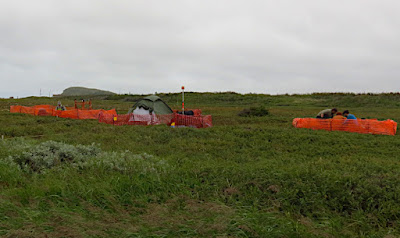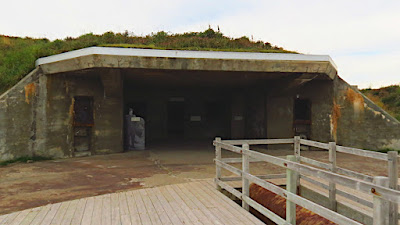I knew from Google maps that our drive from Deer Lake to L'Anse aux Meadows would take us along the coast, so I expected some nice scenery. I had no idea what the road would be like, whether we'd find places to stop for breaks, or how much traffic we'd encounter, though I suspected the answer to the traffic question would be "not much."
We picked up Highway 430, which would take us most of the way to our destination, just outside the airport and began our journey. The rental company had graciously given us a free upgrade (or else they didn't have anything else on the lot), so we were ensconced in a nicely appointed CUV instead of the much smaller sedan I'd picked.
 |
| Flowers Cove, one of many villages along the coastal drive to L'Anse aux Meadows. |
If you look at a map of Newfoundland, you'll see that the island is shaped like a mitten, only with an exaggeratedly long thumb, known as the Northern Peninsula -- an apt but somewhat unusual name given that the island has four other peninsulas, none of which are named Southern Peninsula.
We would drive about 40 km (about 26 miles) northwest before reaching an inlet off the Gulf of St. Lawrence, where we spied our first water, and then another 20 or so km before the road bent to the northeast along the coastline. Looking at a map again, you might think you'd be in sight of the water until you turned inland for the leg to L'Anse aux Meadows, but you'd be wrong.
Instead you alternate between being very close to the shore and having the road take you into the middle of evergreen forests, which a Candian government website informs me are mostly types of fir trees. The journey took us through a portion of Gros Morne National Park, through which run the Long Range Mountains. The park is home to the island's second tallest peak, Gros Morne, at 2,648 feet. On the way out we knew we were in mountainous territory, but we were often driving downhill. The return trip afforded us a much better view of the range and impressed us with its size and beauty.
As I said, we'd drive through a bit of forest, then jog toward the coastline, with gorgeous vistas of water, often dotted with islands, that would elicit the appropriate verbal appreciations. Eventually, the forest gave way to lowlands dotted with numerous ponds.
Because it had been rainy, we couldn't tell which of the smaller ones were more or less permanent and which were just low spots filled with the recent rains. But larger ponds, some big enough to be called lakes back home, were scattered about as well. The largest of the ponds show up on the map we had, with names such as Parson's Pond, Portland Creek Pond and Western Brook Pond. One lake, smaller than some of the ponds, is called River of Pond Lake.
Our highway comprised two lanes, and the speed limit was 90 kph (56 mph) except when traveling through villages, which we did. A lot. Then the limit dropped, most of the time, to 50 kph (31 mph). I began by scrupulously obeying the maximum posted limits because I didn't want to be stopped by a Canadian police officer. I had no idea whether they issued warnings. Turns out that wasn't a problem. We never saw a police vehicle on the trip there and back.
Most of the Canadians (I assume, unless like me, they were U.S. tourists driving rentals) drove much faster. I matched speed a couple of times, and found they drove about 110, close to 70 mph. I eventually settled into driving at 100, dropping to the proper in-town speeds, which most everyone seemed to obey.
 |
Flowers Cove, closer view. Note the simple construction of most of the buildings. The
church features a steeple, an unusual sight in most of the towns we passed through.
|
We passed through numerous towns, all, according to our map, of 500 or less population. The towns pretty much followed the pattern of wherever a cove with a decent beach was, a town was. In one stretch of about 100 kilometers, we passed through or very near 18 towns, some so close to each other that we might see a 90 kph speed sign and almost not have enough time to hit that speed before slowing for the next town. Most of these tows had "cove" in their names: Blue Cove, Black Duck Cove, Pigeon's Cove, Deadman's Cove, and my favorite, Nameless Cove, among them.
A ferry stops near Pigeon's Cove, so large it almost looks like a cruise ship. This ferry runs between Newfoundland and Quebec, quite close to the Labrador border.
About two-thirds of the way, after passing the last of the coves -- Eddies Cove -- the highway curves toward the interior of the peninsula, where we saw acres upon acres of fir trees, like so many perfect Christmas trees. I wish I had developed my poetic side so I could adequately express how captivating this drive along the coast is. Or perhaps that I had not forgotten the spare battery and charging cable for my action camera and had used it to record parts of the drive so you could see for yourself.
The houses in all these little villages were mostly made in what is known as cracker-box style - one or two story rectangular boxes with gables roofs. Occasionally you might see a house built in an "l" or a "t," but those were just two boxes fitted together. The ones nearest the coast usually stood on stilts, and most of the time the only way to distinguish one house from another was its color. White was very popular. Churches followed the same pattern, and the presence of a cross on the end of the building served to distinguish them from a large house or a shop of some kind.
During both legs of the trip we encountered light rain and fog, with occasional outbreaks of the sun, but the fog along the coastline was worst on our trip back to Deer Lake. We slowed down, but given the amount of traffic on anyone section of the road, we were in little danger of running up someone's tailpipe unawares.
We encountered some road construction, but the worst of it, a cut-down to one lane, was controlled by a temporary traffic light, not flagmen. On our way out, the light on our side wasn't working, so we had to wait until we didn't see anyone coming before proceeding. Not that this was a problem. No traffic stacked up behind us, and we had plenty of sight line to give us confidence. The light on the return worked just fine.
Traffic picked up measurably as we neared Deer Lake, but it wasn't anything like driving at home. We had time to kill before returning our car and catching our flight, so we decided to grab a bite to eat. We tried a Tim Horton's near the airport, but their electronic menu boards were down, and the woman who tried to help us was a very nice woman who did not speak English as her first language. She must have been new because she didn't know the menu, and when we asked what they had, she referred us to the electronic menus. We tried to communicate for a short time but gave up and went somewhere else.
At the airport, our flight was delayed by about an, presumably because of a rain storm that blew through No PA announcement was made, and we only knew about the change because I looked at the flight board at the gate and noticed the departure time had changed. Even then, we wound up leaving later than the posted time.
The mall claims it has 140 stores, and construction was underway to expand its capacity, not something you see a lot with American malls. We didn't recognize any of the chains stores, except in the food court, where we knew one or two of the places, but I can't recall which ones they were. After a bite -- Chinese food that was pretty good for a mall cafe -- we returned to the hotel and settled in.
Some random observations:
Say What?
Like most places, Newfoundland has its share of unique expressions. We didn't hear any of them, except for the one waitress who called us "m'dear" or "m'dears" all the time. That might not seem so different from the "dear" or "dearie" or "hon" you hear often in this part of the woods, but she had a bit of an accent and a cheery manner that made it seem charming none the less. I tried out what I had read was a oft-used greeting, "Whaddayat," basically "what's up," and only received laughs in reply. Must have sounded to much like a tourist. If you'd like to hear some other expressions , YouTube has plenty of videos about the subject, but I like this one best: Newfoundland expressions
Canadians are so polite ...
... even the panhandlers are nice to you. A few hit me up in downtown, and when I apologized and said I didn't have any cash with me -- which was true, by the way -- they usually responded with, "Oh, that's OK. Thanks."
Yummies
St. John's is a blend of the old and the modern. Much of the town north of downtown looks like any suburban town just about anywhere in the U.S. Of course that means you run across your share of chain stores, most of which you've never heard of. They do have Circle K, with all the soda selections you recognize, though they are big on ginger ale as well. Two of the most ubiquitous chains are the fast-food places Mary Brown's Chicken and Taters, and Tim Horton's.
Tim Horton's wins hands down for the number of restaurants, though. If they are smaller places, they pretty much just serve coffee, pastries and breakfast sandwiches. The larger ones also advertise hamburgers. We had muffins and soft drinks, sold in the metric equivalent of 20 oz. bottles, there a couple of times, but nothing else. We ate at a Mary Brown's one time, basically it's not-bad fried chicken sold with what we would call cottage fries. OK, but nothing to write home about.
I had intended to try a Canadian dish called poutine, but never got around to it. It's fries covered in gravy and cheese curds. A search on Google shows poutine to be available in the Metroplex, but I didn't spend anytime looking at menus to see if this is true.
Gassing Up
I had to buy gas a few times during our stay. In the Northern Peninsula I paid C$2.27 a liter, which works out to almost US$7 a gallon, if I did the math right. In Deer Creek and St. John's, gas cost about C$1.25 a liter, or something close to US$3.80 a gallon. Good thing we drove cars with high gas mileage.
Coming Home
We flew into and out of Toronto, which was our major connection point for the flights to an from St. John's. Going through customs when entering the country was a breeze, and with three hours layover time, quite stress free. The agent who checked us through looked like someone out of central casting in Hollywood. Blond, good-looking, obviously fit. He ignored me completely when I remarked on that fact to Sharon.
But Toronto is a port of entry on the way back. I'd scheduled our departure for Dallas to be just an hour and a half after our arrival, which should have been plenty of time if all the flights were on time, and they were.
We thought we'd head over to our gate, grab a quick bite for lunch and wait for our flight. But we had to go through security, and not the kind of internal security for flights within country. Nope, this was full-on go through customs, then face a TSA style security check. On top of that, my ticket was marked for a random full security check. And with what seemed like thousands of people who needed to be process, I became worried about time.
I thought my screening would take much more time than Sharon's, but she got stuck behind some yahoo who needed extra attention, and we wound up clearing security at about the same time. A check of the clock showed us we'd need to hustle to make our flight. As we entered the corridor leading to our gate, we heard a last-call announcement for our flight along with our names. We broke into a trot and managed to board, but we've never cut a flight that close before.
Moral of the story: Make sure you know if you're passing through a POE, and leave plenty of time to catch your flight.
 |
| Humor outside a shop. |













































